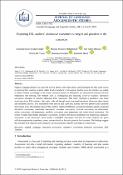Options
Exploring ESL teachers’ alternative assessment strategies and practices in the classroom
Journal
Journal of Language and Linguistic Studies
Date Issued
2022
Author(s)
Charanjit Kaur Swaran Singh
Mazura Mastura Muhammad
Nor Azmi Mostafa
Melor Md Yunus
Nooreen Noordin
Ramiaida Binti Darmi
DOI
10.52462/jlls.191
Abstract
English Language teachers are expected to keep abreast with expectations and challenges that they come across in assisting their students to attain higher level of academic achievement. Studies show that teachers are unable to assess students accordingly as the current education system in Malaysia is too examination-oriented and over emphasises rote-learning. The research aims at investigating and analysing in-service teachers’ alternative assessment strategies in selected Malaysian ESL classrooms. This study employed a qualitative case study involving eleven ESL teachers. Data were collected through semi-structured interviews, classroom observations and document analysis. Two instruments were used in data collection, namely interview protocol and classroom observation form. The findings showed that teachers employed different assessment strategies namely integrated alternative assessment, summative assessment, formative assessment, informal assessment via observation, online assessment, self-assessment, portfolio assessment, peer assessment and school-based assessment. The results revealed that besides alternative assessment, teachers still showed preference for employing summative assessment in the classroom. Some teachers embedded assessment activities to ensure students are given sufficient opportunity to perform, create, produce based on the tasks given in the classroom. The findings suggest that teachers need exposure and training in current assessment that they can employ in instruction.
Subjects
File(s)
Loading...
Name
236. Exploring ESL Teachers’ Alternative Assessment Strategies And Practices In The Classroom.pdf
Size
322.73 KB
Format
Adobe PDF
Checksum
(MD5):7b06e9fdead7138078f8a38a2634be34